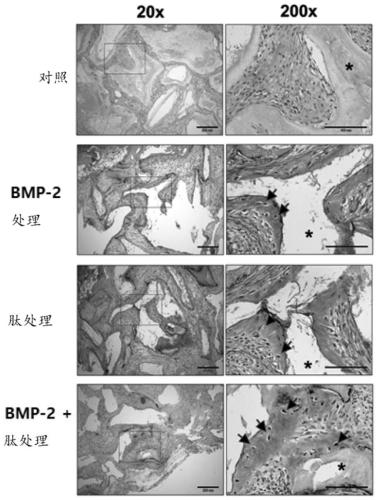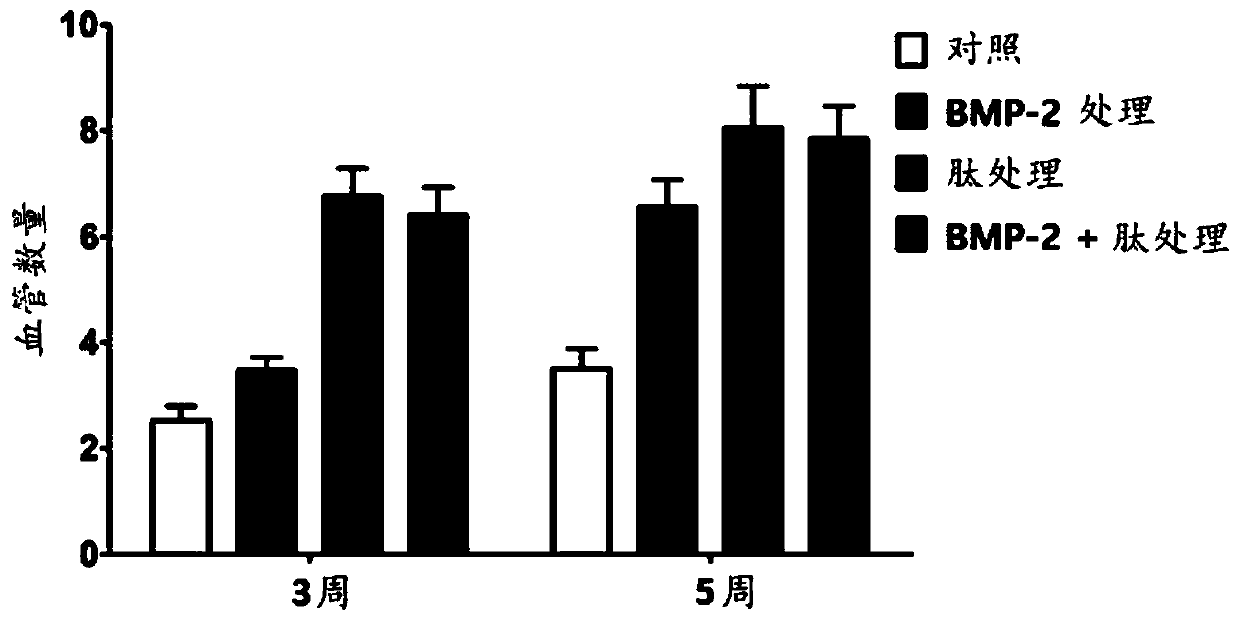Peptide for promoting osteoanagenesis or osteogenesis and use of same
A technology of bone regeneration and derivatives, applied in the direction of medical preparations containing active ingredients, peptides, bone diseases, etc., can solve the problems of undeveloped effective and powerful drug candidates, and achieve storage and stability advantages, chemical structure Simple, bone regeneration-promoting effect
- Summary
- Abstract
- Description
- Claims
- Application Information
AI Technical Summary
Problems solved by technology
Method used
Image
Examples
Embodiment 1
[0194] Example 1. Preparation of peptides of the present invention
[0195] The peptides used in the examples were synthesized by the 9-fluorenylmethoxycarbonyl (Fmoc) method (Lugen Sci, Korea; Peptron, Korea). In order to confirm the reproducibility of the experimental results using peptides, the same group of peptides were independently synthesized 2 or 3 times by Lugen Sci and Peptron, respectively. Consistent results were obtained from peptides synthesized from different companies and between different batches.
Embodiment 2
[0196] Example 2. Effect of peptides of the invention on cell adhesion as a major mechanism of bone regeneration
[0197] Peptides having the sequence represented by SEQ ID NO: 17 were used to test the peptides of the present invention for promoting bone regeneration in a xenograft bone model and in the following examples unless otherwise stated.
[0198] As described below, each of the following four groups was transplanted onto the backs of immunodeficient mice using graft materials having the components shown in Table 2, and the newly formed hard tissues were analyzed at 3 and 6 weeks after transplantation. organize. The doses used are as follows: Geistlich Bio-Oss: 100 mg; hDPSC (human dental pulp stem cells): 5x10 6 Cells; peptide according to the invention: 10 μg; and BMP-2 (BD Science): 2 μg (Kevin et al., Adv Drug Deliv Rev. 2012; 64:1277-1291).
[0199] Table 2
[0200]
[0201] For animal experiments, 6-week-old immunocompromised mice (NIH-bg-nu / nu-xid, HarlanS...
Embodiment 3
[0207] Example 3. Promotion of bone regeneration in a calvarial defect model by the peptides of the invention.
[0208] Using a skull defect model, the bone regeneration ability of the peptides according to the present invention was analyzed as follows.
[0209] First, transplanted materials having components corresponding to the respective conditions in Table 3 were used as animal models on laboratory rats. Eight-week-old male rats were used to avoid errors caused by hormonal changes. The experimental animals were bred and managed according to the standards of the Experimental Animal Center of Seoul National University. After preparing the implants according to the conditions shown in Table 3, fractures of specific sizes were surgically induced in the skulls of rats and treated with the implants. At 3 and 5 weeks after transplantation, newly formed bone tissue was examined. Bone regeneration peptide and BMP-2 were diluted in saline, and the same volume of saline was used a...
PUM
| Property | Measurement | Unit |
|---|---|---|
| diameter | aaaaa | aaaaa |
Abstract
Description
Claims
Application Information
 Login to View More
Login to View More - R&D
- Intellectual Property
- Life Sciences
- Materials
- Tech Scout
- Unparalleled Data Quality
- Higher Quality Content
- 60% Fewer Hallucinations
Browse by: Latest US Patents, China's latest patents, Technical Efficacy Thesaurus, Application Domain, Technology Topic, Popular Technical Reports.
© 2025 PatSnap. All rights reserved.Legal|Privacy policy|Modern Slavery Act Transparency Statement|Sitemap|About US| Contact US: help@patsnap.com



